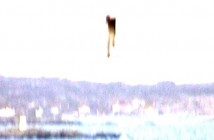For an alternate take on Hugo, check out Kevin Ketchum’s review.
There is no more passionate film fan – and no greater proponent of film preservation – than Martin Scorsese. In a career spanning nearly 50 years, Marty has redefined the art form nearly every time he has stepped behind the camera, informing the thematic and stylistic preoccupations of countless up-and-coming filmmakers. No one, however, can surpass him in terms of the sheer will to explore all the ways in which cinema can be twisted and contorted while never wavering in his reverence for the filmic traditions that have evolved over time.
It is appropriate, then, that his latest film simultaneously breaks new ground while celebrating the earliest days of film history. Hugo, based on Brian Selznick’s book, The Invention of Hugo Cabret, is notable for being Scorsese’s first foray into the realm of 3D filmmaking, as well as his first, in 26 features, to be classified as a “family film.” However, beyond those surface labels, Hugo is a film about film – the beginnings of film, the passion for film, the importance of preserving and restoring film so that we may never forget where this glorious art form came from. It may not be Scorsese’s best film, but it could be seen as a culmination of his career up to this point – living and breathing cinema for a lifetime has led to this gorgeous love letter to his filmic ancestors, whose boundless creativity clearly inspired Scorsese’s own. It will likely serve as a palate cleanser for what I expect to be an urgent, vigorous, brilliant next act in his career.
Scorsese’s camera glides through an expressive cinema fantasy version of 1930s Paris as the film opens, blending intentionally-artificial CG with live action sets that are dripping in sumptuous Art Direction; from the opening shot, we are instantly immersed in a vivid world of Marty’s creation. The first 10 minutes establish all the major characters as they maneuver through the elaborate train station at the film’s center—which itself becomes a character—in what is essentially a live-action short in the spirit of French animation, a nearly wordless jaunt with touches of humor and melancholy. We meet the titular hero (Asa Butterfield), who lives inside the station’s walls, among the gears of its towering clock structure. He’s a lonely orphan who keeps the clocks running on time, swipes croissants from the patisserie, and occasionally sneaks off to the cinema, where the glorious moving images help him escape from his isolated life. Hugo can observe everything from his post, from the dastardly Station Inspector (Sacha Baron Cohen) thirsty to arrest thieving children to the cantankerous novelty shop owner (Ben Kingsley) who seems to have long ago lost his imagination, and whose granddaughter (Chloe Grace Moretz) becomes Hugo’s only friend.
These characters are woven together in a plot that is simple but intricate, slowly revealing the depths of its characters in an adventure involving a rusty automaton that Hugo keeps in his clock tower home. His father (Jude Law) died before he was able to make the machine work again, and now Hugo has continued the pursuit, believing that it perhaps contains a message from his dad. There is indeed a message, one that unexpectedly opens a window to film history that informs the remainder of the story. Hugo starts by celebrating the cinema with its style and form, and concludes by celebrating the cinema with its content, as well. It concludes in the most dazzling film history lesson you will ever see.
Parallels to the director’s life are myriad. As Hugo sits isolated in his Paris hideout, looking out at the world below, so sat an asthmatic Marty looking out his apartment window in Little Italy, too sick to go out and play. In the same way that Hugo takes refuge in the arts, so did young Scorsese find his bliss in the movies he watched in those rare moments when he was able to venture out into the world. And as Hugo unwittingly becomes the spearhead for reviving a “cinemagician’s” soul, so has Scorsese become the world’s most prominent voice for film restoration. Hugo functions as a sort-of biopic for its maker, filtered through the magic and wonder of the cinema that defines him.
At a stage when the use of 3D has become ubiquitous and often perfunctory, Scorsese absorbs its rhythms to create a fully realized cinematic universe, filled not with pop-up “gotcha!” moments but true atmospheric depth. Hugo’s 3D is dazzling for its subtlety, working seamlessly with the meticulous Art Direction to envelope the audience and allowing characters to occasionally emerge from the screen, their most intense emotional moments slowly bursting through its confines. Scorsese’s is the most masterful and reverent use of 3D in modern film history, made all the more appropriate that it’s used to tell a story about the magical invention of filmmaking. The world’s greatest living director has composed the cinema’s most passionate love note to the art form he has seemingly mastered, yet still he pushes further, with a zeal to grow, learn, and expand. With Hugo, he hopes to ignite that passion in audiences of all ages.
[notification type=”star”]91/100 ~ AMAZING. Martin Scorsese’s glorious Hugo is a piece of cinema that celebrates cinema itself; it is the most passionate love note to the art form ever composed.[/notification]




